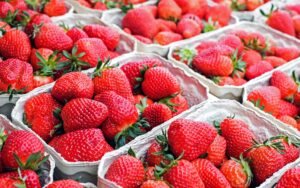Season: March through November in Northern California
History: There are native varieties of wild strawberries in both the Old and New Worlds, ranging from South America to Europe to Asia. A member of the Rosaceae family (along with roses, apples and blackberries), they have been cultivated in Europe since the 14th century, though there is some evidence that Native Americans may have gardened the North American wild variety even earlier (and created one of the first versions of strawberry shortcake, made by mixing them with cornmeal). The varieties of the berry commonly grown in the United States today were developed in 19th century England — until hybridization with larger, juicier varieties, earlier cultivated strawberries were tiny, much like wild strawberries and the highly prized fraises des bois variety available today.
Flavor: Sweet and juicy with a touch of acidity. When shopping, look for glossy, red fruit without visible bruised, mushy or moldy spots.
Storage: Fresh strawberries deteriorate quickly after purchase — the culprit primarily being mold. You can keep the fruit fresher by waiting to wash them until just before eating, and by storing them in the refrigerator in a paper-towel lined basket or bowl.
How to use: Strawberries are a versatile fruit. They can be roasted, stewed, baked into a pie, made into jam, pickled, churned into ice cream or frozen into an icy sorbet.
But strawberries really shine when eaten raw, either completely unadorned, or sliced and tossed with a bit of sugar, orange juice, red wine or balsamic vinegar. Tossing a fruit with sugar and a bit of acidic liquid (“macerating” the fruit) draws out the delicious juices, enhances the flavor and makes a natural “sauce” for topping shortcakes or ice cream.
Nutrition: Strawberries are high in Vitamin C, fiber and manganese. The berries are also a fairly good source of folate and potassium, and are low in calories.


